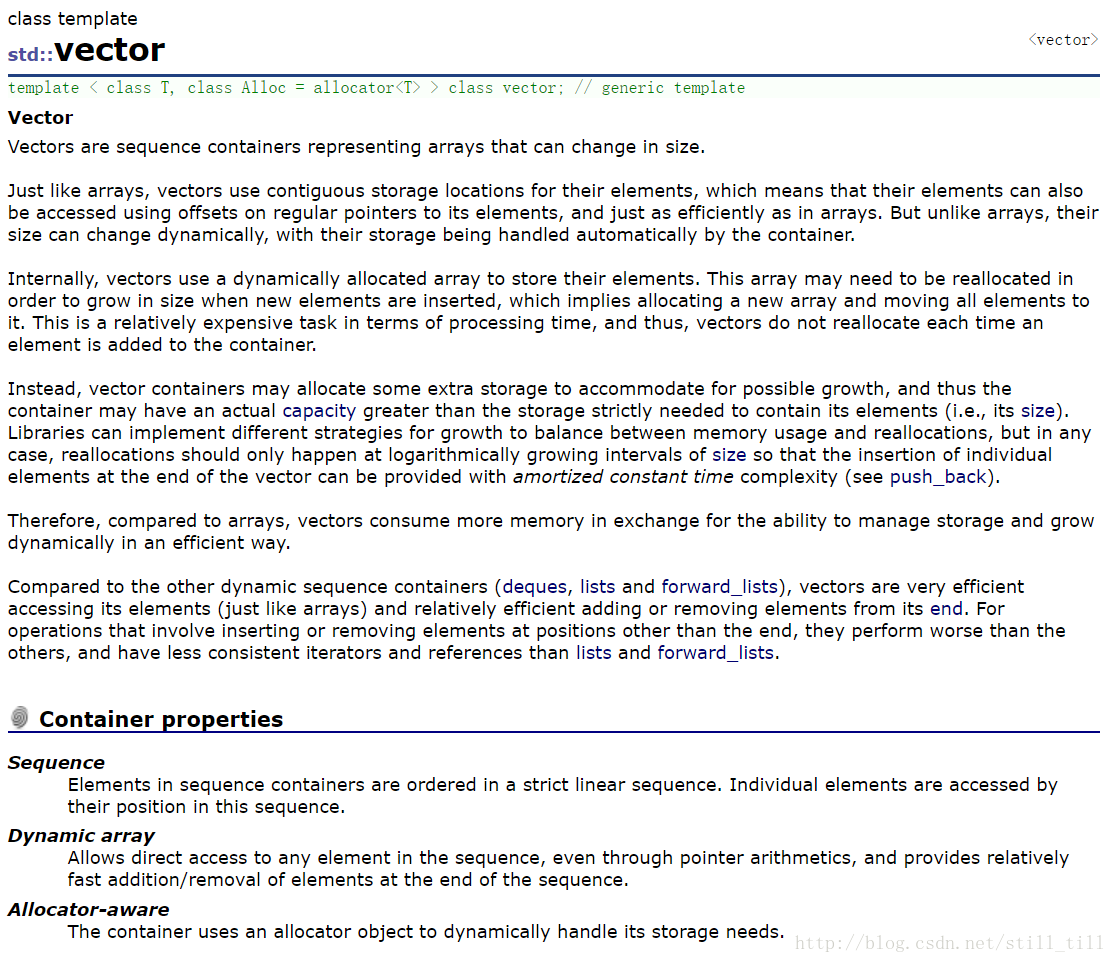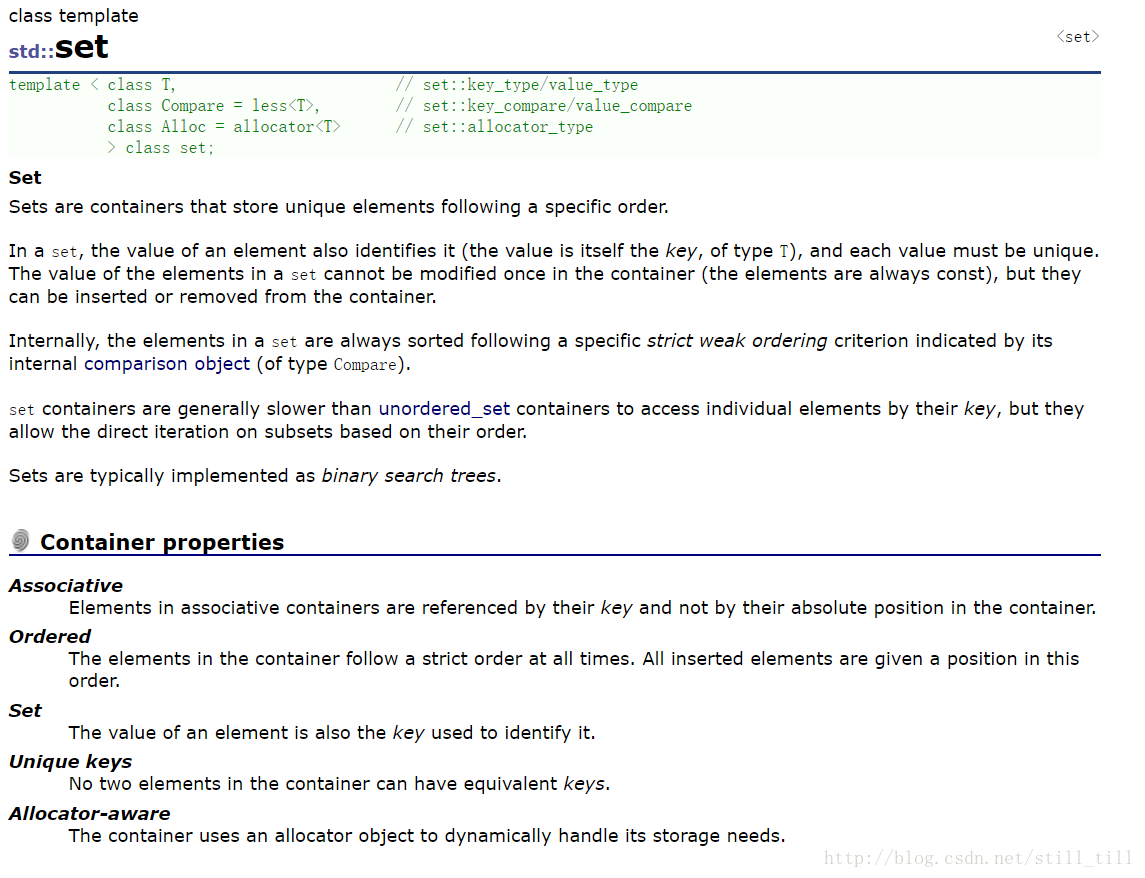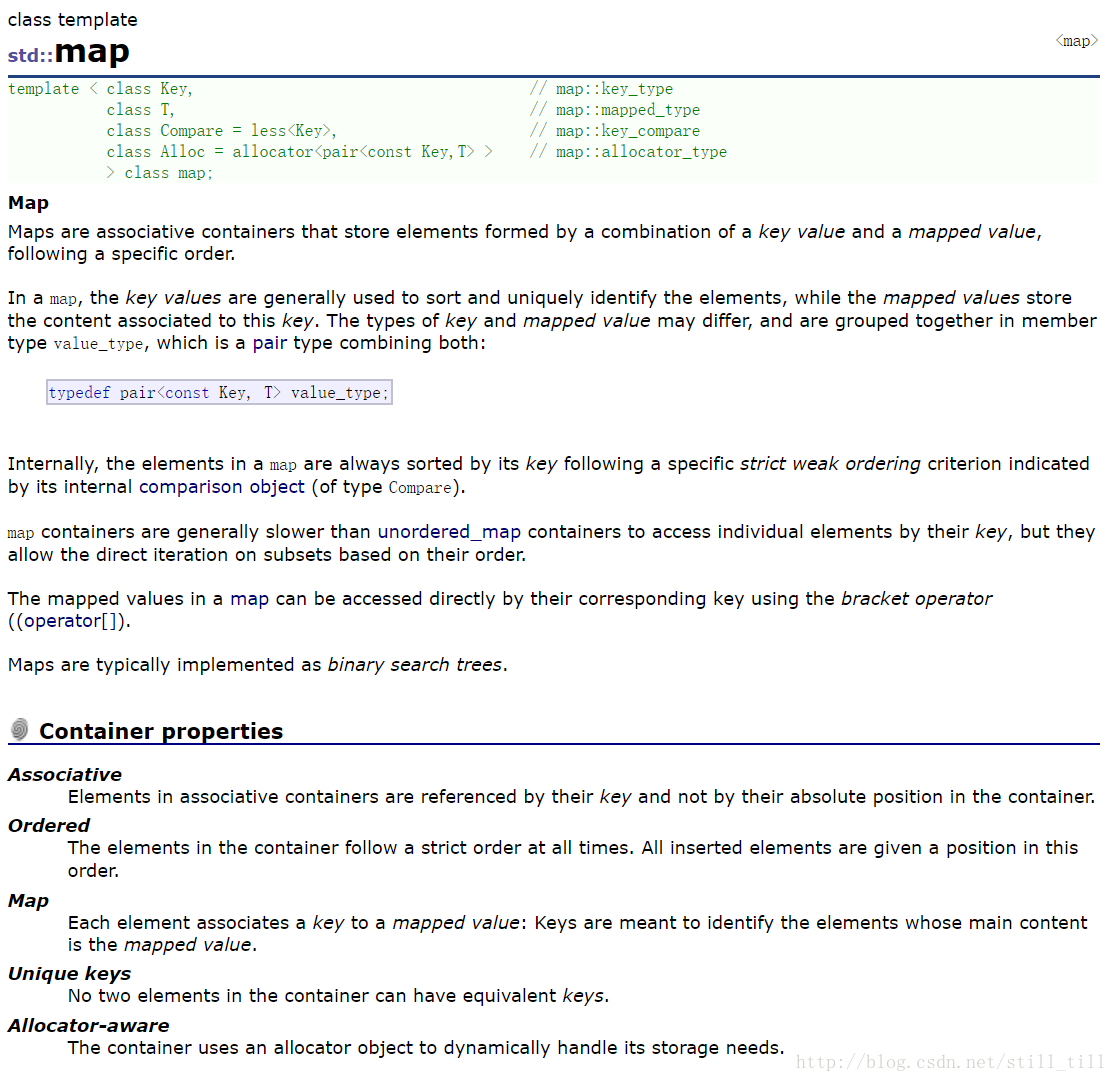C++部分特性整理
1.C语言大部分头文件在c++中仍可以适用,但推荐在C头文件之前加一个小写的字母c,然后去掉.h后缀。如cstdio,cstring,cmath,cctype
2.C++中可以使用流简化输入输出操作,但缺点是运行太慢
3.头文件iostream和algorithm里定义的内容放在std名称空间,可以用using namespace std的方法把std里的名字导入默认空间。这样就可以用cin代替std::cin,cout代替std::cout,min代替std::min
4.声明数组时,数组大小可以使用const声明的常数,而不是用#define声明常数
5.C++中引用是变量的别名,可以在一定程度上代替C中的指针。按照传引用(by reference)的方式,而不是传值(by value)方式传递参数,若在函数内改参数的值,也会修改到函数的实参。
例:使用引用交换两个变量的方法如下:
#inclued<iostream>
using namespace std;
void swap2(int &a,int &b){
int t=a; a=b; b=t;
}
int main(){
int a=3,b=4;
swap2(a,b);
cout<<a<<" "<<b<<endl;
return 0;
}6.C++提供了string类型用来替代c语言中的字符数组。cin/cout可以直接读写string类型(速度有点慢),却不能读写字符数组,string类型还可以像整数那样相加。
考虑这样一个问题:输入数据的每行包括若干个(至少一个)以空格隔开的整数,输出每行中所有整数之和。
#include<iostream>
#include<string>
#include<sstream>
using namespace std;
int main(){
string line;
while (getline(cin,line)){
int sum=0,x;
stringstream ss(line);
while (ss>>x) sum+=x;
cout<<sum<<endl;
}
return 0;
}首先用getline函数读取一行数据,然后用这一行创建一个字符串流–ss,之后只需像读取cin那样读取ss即可。
*注:虽然string和sstream都很方便,但string很慢,sstream更慢,应谨慎使用
7.C++中结构体和模板使用实例
#include <iostream>
using namespace std;
template<typename T>
struct Point{
T x,y;
Point(T x=0,T y=0):x(x),y(y){}
};
template<typename T>
Point<T> operator + (const Point<T>& A,const Point<T>&B){
return Point<T>(A.x+B.x,A.y+B.y);
}
template<typename T>
ostream& operator << (ostream &out,const Point<T>& p){
out<<"("<<p.x<<","<<p.y<<")";
return out;
}
int main(){
Point<int> a(1,2),b(3,4);
Point<double> c(1.1,2.2),d(3.3,4.4);
cout<<a+b<<" "<<c+d<<endl;
return 0;
}例题5-1 大理石在哪儿(Where is the Marble?,UVa10474)
此题非常简单,只需先排序后查找即可。可使用alogrithm头文件中的sort和lower_bound分别完成所需操作并简化代码,函数使用方法如下:
sort函数有三个参数:
(1)第一个是要排序的数组的起始地址。
(2)第二个是结束的地址(最后一位要排序的地址的下一地址)
(3)第三个参数是compare函数,即排序的方法,若省略此参数则默认用”<”进行排序
lower_bound()返回一个 iterator,它指向在[first,last)标记的有序序列中可以插入value,而不会破坏容器顺序的第一个位置,而这个位置标记了一个不小于value 的值
#include <iostream>
#include <algorithm>
using namespace std;
int main(){
int a[10000];
int n,q,kase=0,x,i;
while (cin>>n>>q && n){
for (i=0;i<n;i++)
cin>>a[i];
sort(a,a+n); //排序
printf("CASE# %d:n",++kase);
while (q--){
cin>>x;
/*
for (i=0;i<n;i++)
if (a[i]==x){
printf("%d found at %dn",x,i+1);
break;
}
if (i==n)
printf("%d not foundn",x);
*/
int p=lower_bound(a,a+n,x)-a; //在已排序数组a中寻找x
if (a[p]==x)
printf("%d found at %dn",x,p+1);
else
printf("%d not foundn",x);
}
}
}(algorithm头文件中的sort可以给任意对象排序,包括内置类型和自定义类型,前提是该类型定义了”<”运算符,或着需传入额外的比较函数。排序之后可以用lower_bound查找大于或等于x的第一个位置。待排序/查找的元素可以放在数组里,也可以放在vector里。前者用sort(a,a+n)的方式调用,后者用sort(v.begin(),v.end())的方式调用。)
例题5-2 木块问题(The Blocks Problem,UVa101)
由于每个木块堆的高度不确定,用vector这一数据结构来存储非常合适。vector是一个不定长数组,可以用clear()清空,resize()改变大小,用push_back()和pop_back()在尾部添加和删除元素,用empty()测试是否为空。vector之间可以直接赋值或者作为函数的返回值,像是“一等公民”一样。此题代码是vector这一数据结构的典型应用。另外此题还包含着处理输入指令的技巧,即提取出指令之间的共同点,编写函数以减少重复代码。

#include <iostream>
#include <vector>
#include <string>
using namespace std;
vector<int> pile[30]; //每个pile[i]是一个vector
int n;
//找木块a所在的pile和height,以引用的形式返回调用者
void find_block(int a,int& p,int&h){
for (p=0;p<n;p++)
for (h=0;h<pile[p].size();h++)
if (pile[p][h]==a)
return;
}
//把第p堆高度为h的木块上方的所有木块移回原位
void clear_above(int p,int h){
for (int i=h+1;i<pile[p].size();i++){
int m=pile[p][i];
pile[m].push_back(m); //把木块放回原位
}
pile[p].resize(h+1); //pile[p]中只保留0-h的元素
}
//把第pa堆高度为h及其上方的木块整体移动到pb堆的顶部
void pile_onto(int pa,int pb,int h){
for (int i=h;i<pile[pa].size();i++)
pile[pb].push_back(pile[pa][i]);
pile[pa].resize(h);
}
int main(){
string s1,s2;
int a,b;
scanf("%d",&n);
for (int i=0;i<n;i++)
pile[i].push_back(i);
while (cin>>s1 && s1!="quit" && cin>>a>>s2>>b){
int pa,pb,ha,hb;
find_block(a,pa,ha);
find_block(b,pb,hb);
if (pa==pb)
continue;
if (s1=="move")
clear_above(pa,ha);
if (s2=="onto")
clear_above(pb,hb);
pile_onto(pa,pb,ha);
}
for (int i=0;i<n;i++){
printf("%d:",i);
if (!pile[i].empty())
for (int h=0;h<pile[i].size();h++)
printf(" %d",pile[i][h]);
printf("n");
}
return 0;
}例题5-3 安迪的第一本字典(Andy’s First Dictionary,UVa10815)
此题是set集合的典型应用实例。set容器中每个元素只能出现一次且是有序的,不支持下标访问元素。自定义类型也可以构造set,但同样需定义小于运算符。

#include <iostream>
#include <string>
#include <set>
#include <sstream>
using namespace std;
set<string> dict; //string集合
int main(){
string s,buf;
while (cin>>s){
for (int i=0;i<s.length();i++)
if (isalpha(s[i]))
s[i]=tolower(s[i]);
else
s[i]=' ';
stringstream ss(s);
while (ss>>buf)
dict.insert(buf);
}
for (set<string>::iterator it=dict.begin();it!=dict.end();it++)
cout<<*it<<endl;
return 0;
}此题中还使用到了迭代器,这里简要摘录一些有关迭代器的概念和用法

容器中都拥有成员begin和end,其中begin成员复制返回指向第一个元素(或第一个字符)的迭代器,而end成员返回指向容器(或string对象)尾元素的下一个位置的迭代器

例题5-4 反片语 (Ananagrams,UVa156)
此题是map和vector的综合应用。解题关键在于先把每个单词“标准化”,即全部转化为小写字母并排序后,在放到map中统计已标准化单词的出现次数。map是从键到值的映射,重载了[]运算符,具体介绍见下图:

set和map都支持insert,find,count和remove操作,并且可以按照从小到大的顺序循环遍历其中的元素。map还提供了“[]”运算符,使得map可以像数组一样使用,事实上,map也称为“关联数组”。
#include <iostream>
#include <string>
#include <map>
#include <vector>
#include <algorithm>
using namespace std;
map<string,int> cnt; //记录经"标准化"后单词的出现次数
vector<string> words;
//将单词s进行"标准化"
string standardize(const string& s){
string temp=s;
for (int i=0;i<s.length();i++)
temp[i]=tolower(temp[i]);
sort(temp.begin(),temp.end());
return temp;
}
int main(){
string s;
while (cin>>s){
if (s[0]=='#')
break;
words.push_back(s);
string s1=standardize(s);
if (cnt.count(s1)==0)
cnt[s1]=0;
cnt[s1]++;
}
vector<string> ananagrams;
for (int i=0;i<words.size();i++)
if (cnt[standardize(words[i])]==1)
ananagrams.push_back(words[i]);
sort(ananagrams.begin(),ananagrams.end());
for (int i=0;i<ananagrams.size();i++)
cout<<ananagrams[i]<<endl;
return 0;
}例题5-5 集合栈计算机(The SetStack Computer,UVa12096)
此题为每个不同的集合映射为一个唯一的ID,将不同集合的集合转化为对应的ID的集合。同时用到了栈这一先进后出的数据结构,通过push(),pop()完成入栈和出栈操作,top()取栈顶元素。
#include <iostream>
#include <vector>
#include <stack>
#include <map>
#include <set>
#include <algorithm>
using namespace std;
#define ALL(x) x.begin(),x.end()
#define INS(x) inserter(x,x.begin())
typedef set<int> Set;
map<Set,int> IDcache; //把集合映射成ID
vector<Set> Setcache; //根据ID取集合
//查找给定集合的ID,如果找不到,分配一个新ID
int ID(Set s){
if (IDcache.count(s))
return IDcache[s];
Setcache.push_back(s); //添加新集合
return IDcache[s]=Setcache.size()-1;
}
int main(){
int t,n;
cin>>t;
while (t--){
cin>>n;
stack<int> s;
while (n--){
string op;
cin>>op;
if (op[0]=='P')
s.push(ID(Set()));
else if (op[0]=='D')
s.push(s.top());
else{
Set s1=Setcache[s.top()];
s.pop();
Set s2=Setcache[s.top()];
s.pop();
Set x;
if (op[0]=='U')
set_union (ALL(s1),ALL(s2),INS(x));
if (op[0]=='I')
set_intersection (ALL(s1),ALL(s2),INS(x));
if (op[0]=='A'){
x=s2;
x.insert(ID(s1));
}
s.push(ID(x));
}
cout<<Setcache[s.top()].size()<<endl;
}
cout<<"***"<<endl;
}
return 0;
}例题5-6 团体队列(Team Queue,UVa540)
此题为队列这一先进先出数据结构的应用,通过push()和pop()进行入队和出队的操作,front()取队首元素()。同时再一次应用到了map映射集合,将队员与其对应团队序号相对应。
#include <iostream>
#include <queue>
#include <map>
using namespace std;
int main(){
int n,t,kase=0,x;
while (scanf("%d",&t) && t){
printf("Scenario #%dn",++kase);
//记录所有团队成员的编号
map<int,int> team; //team[x]表示编号为x的人所在的团队编号
for (int i=0;i<t;i++){
scanf("%d",&n);
while (n--){
scanf("%d",&x);
team[x]=i;
}
}
char cmd[10];
queue<int> q,qteam[1000]; //q是团队队列,qteam是每个团队的队列
while (true){
scanf("%s",cmd);
if (cmd[0]=='S')
break;
if (cmd[0]=='E'){
scanf("%d",&x);
int t=team[x];
if (qteam[t].empty()) //如果队列中没有x所在团队的队员,则让x所在团队入队
q.push(t);
qteam[t].push(x);
}
else if (cmd[0]=='D'){
int t=q.front();
printf("%dn",qteam[t].front());
qteam[t].pop();
if (qteam[t].empty()) //若此团队所有队员已出队,则整个团队出队
q.pop();
}
}
printf("n");
}
return 0;
}例题5-7 丑数(Ugly Numbers,UVa136)
此题应用了优先队列。由于对于任意的丑数x,2x、3x和5x也都是丑数,故可以用一个优先队列保存所有已生成的丑数,每次取出最小的丑数,生成3个新的丑数。此外用一个集合来判断一个丑数是否已经生成过。
queue头文件中提供了优先队列,用priority_queue定义(后跟的尖括号内定义元素类型),通过push()和pop()进行入队和出队的操作,top()取队首元素()。自定义类型也可以组成优先队列,但必须为每个元素定义一个优先级。
#include <iostream>
#include <queue>
#include <set>
using namespace std;
int main(){
const int coeff[3]={2,3,5};
typedef long long LL;
priority_queue<LL,vector<LL>,greater<LL> > pq;
set<LL> s;
pq.push(1);
s.insert(1);
for (int i=1;;i++){
LL x=pq.top();
pq.pop();
if (i==1500){
printf("The 1500'th ugly number is %d.n",x);
break;
}
for (int j=0;j<3;j++){
LL m=x*coeff[j];
if (s.count(m)==0){
s.insert(m);
pq.push(m);
}
}
}
return 0;
}随机数及STL测试
1.cstlib中的rand()可生成闭区间[0,RAND_MAX]内均匀分布的随机函数,其中RAND_MAX至少为32767。
2.在精度要求不高的情况下,可以在执行rand()之后先除以RAND_MAX,得到[0,1]之间的随机实数,扩大n倍后四舍五入,得到[0,n]之间的均匀整数。
3.可以用cstdlib中的srand函数初始化随机数种子。如果需要程序每次执行时使用一个不同的种子,可以用ctime中的time(NULL)为参数调用srand。一般来说,只在程序执行的开头调用一次srand。
4.把vector作为参数或者返回值时,应尽量改成用引用方式传递参数,以避免不必要的值被复制。
5.测试时往往使用assert。其用法时”assert(表达式)”,当表达式为假时强行终止程序,并给出错误提示。
6.vector,set,map都很快(并不是所有操作),其中vector的速度接近数组(但仍有差距),而set和map的速度也远远超过了”用一个vector保存所有值,然后逐个元素进行查找”时的速度。set和map每次插入、查找、删除的时间和元素个数的对数呈线性关系。尽管如此,在一些对时间要求非常高的题目中,STL有时会成为性能瓶颈。
下面是利用随机数测试sort函数的例子:
#include <iostream>
#include <algorithm>
#include <ctime>
#include <vector>
#include <cassert>
using namespace std;
void fill_random_int(vector<int> &v,int cnt){
v.clear();
for (int i=0;i<cnt;i++)
v.push_back(rand());
}
void test_sort(vector<int> v){
sort(v.begin(),v.end());
for (int i=0;i<v.size()-1;i++)
assert(v[i]<=v[i+1]);
}
int main(){
vector<int> v;
srand(time(NULL));
fill_random_int(v,1000000);
test_sort(v);
return 0;
}例题5-8 Unix Is 命令(UVa 400)
此题没什么难度,关键在于输出的细节控制处理,书中的处理方式比较巧妙,值得借鉴。
#include <iostream>
#include <vector>
#include <algorithm>
using namespace std;
void print(const string s,int len,char extra){
cout<<s;
for (int i=0;i<len-s.length();i++)
cout<<extra;
}
int main(){
int n;
while (cin>>n && n){
string s;
vector<string> v;
int maxlen=0;
for (int i=0;i<n;i++){
cin>>s;
v.push_back(s);
if (s.length()>maxlen)
maxlen=s.length();
}
sort(v.begin(),v.end());
int col=(60-maxlen)/(maxlen+2)+1;
int row=(n-1)/col+1;
//printf("maxlen=%d col=%d row=%dn",maxlen,col,row);
for (int i=0;i<60;i++)
cout<<"-";
cout<<endl;
for (int r=0;r<row;r++){
for (int c=0;c<col;c++){
int index=c*row+r;
if (index<n)
print(v[index],c==col-1?maxlen:maxlen+2,' ');
}
cout<<"n";
}
}
}例题5-9 数据库(Database,UVa1592)
此题若直接写四重循环枚举r1,r2,c1,c2会超时。解决方法是只枚举c1和c2,然后从上到下扫描各行。每次碰到一个新的行r,把c1,c2两列的内容作为一个二元组存到一个map中。如果map中的键值已存在,该二元组映射到的就是所要求的r1,而当前行就是r2。二元组的存储用到了“集合栈计算机”中的技巧,不直接存储字符串,而是给所有字符串分配一个编号,二元组中存放的为字符串对应的编号。
#include <iostream>
#include <vector>
#include <map>
#include <string>
using namespace std;
typedef pair<int,int> PII; //表示(r,c1),(r,c2)中所存字符串对应的id组成的二元组
int n,m,db[10005][15],cnt;
map<string,int> id; //为每个不同的字符串分配不同的id
int ID(const string s){
if (id.count(s)==0)
id[s]=++cnt;
return id[s];
}
void find(){
for (int c1=0;c1<m-1;c1++)
for (int c2=c1+1;c2<m;c2++){
map<PII,int> d; //键为PII对,值为行
for (int r=0;r<n;r++){
PII p=make_pair(db[r][c1],db[r][c2]);
if (d.count(p)) {
printf("NOn");
printf("%d %dn",d[p]+1,r+1);
printf("%d %dn",c1+1,c2+1);
return;
}
d[p]=r;
}
}
printf("YESn");
}
int main(){
//freopen("D:\input.txt","r",stdin);
//freopen("D:\output.txt","w",stdout);
while (cin>>n>>m){
getchar();
id.clear();
for (int r=0;r<n;r++){
string s;
getline(cin,s);
int lastpos=-1;
for (int c=0;c<m;c++){
int p=s.find(',',lastpos+1);
if (p==string::npos)
p=s.length();
db[r][c]=ID(s.substr(lastpos+1,p-1-lastpos));
lastpos=p;
}
}
find();
}
return 0;
}最后
以上就是典雅汽车最近收集整理的关于算法竞赛入门经典(第2版)笔记--第5章的全部内容,更多相关算法竞赛入门经典(第2版)笔记--第5章内容请搜索靠谱客的其他文章。








发表评论 取消回复